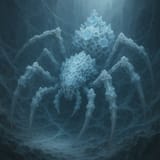Search Results
7/20/2025, 2:50:30 AM
Cryosutura fractalith - “Fractal-threaded cryospawn"
It’s not a spider. Not anymore. But its genome carries echoes of Araneae - an ancient, extinct group that once spun silk in trees. One billion years later, their descendants have dissolved into Earth's post-animal biota. From those remnants emerged Cryosutura fractalith, a quasi-living, self-replicating structure that mimics organismal behavior but is no longer an "animal" in any traditional sense.
Cryosutura is a modular crystal-colony, composed of silicon-lattice chitin nodes arranged in branching, recursive geometry. Each “limb” is a repeating chain of subunits that grow, detach, and recombine depending on local chemical gradients. It doesn’t walk. It assembles, disassembles, and reconfigures.
It exists in the deep shadow regions of Earth’s polar crystal forests - places shielded from direct stellar radiation but rich in geothermal flux and atmospheric ions. There’s no digestion: Cryosutura dissolves minerals, atmospheric organics, and fungal dusts through catalytic fractal surfaces. Energy is stored in ferroelectric folds that open and snap shut like clockwork petals.
There is no mouth. No eyes. No web. But it builds: vast branching fractal matrices, like webs made of ice-glass, threading entire canyons. These are not for catching prey - they’re for gathering data. Cryosutura senses fluctuations in gravity, electric fields, and magnetic shear, reacting by shifting its shape like a kaleidoscope under stress.
It is not conscious. But across its miles-long scaffolds, patterns emerge - pulse rhythms, information blooms, recursive logic knots. Communication may be occurring... through form, not sound.
Predators? None. Parasites? Countless. Life has stopped caring about mouths and eyes. It has learned to think in shapes.
It’s not a spider. Not anymore. But its genome carries echoes of Araneae - an ancient, extinct group that once spun silk in trees. One billion years later, their descendants have dissolved into Earth's post-animal biota. From those remnants emerged Cryosutura fractalith, a quasi-living, self-replicating structure that mimics organismal behavior but is no longer an "animal" in any traditional sense.
Cryosutura is a modular crystal-colony, composed of silicon-lattice chitin nodes arranged in branching, recursive geometry. Each “limb” is a repeating chain of subunits that grow, detach, and recombine depending on local chemical gradients. It doesn’t walk. It assembles, disassembles, and reconfigures.
It exists in the deep shadow regions of Earth’s polar crystal forests - places shielded from direct stellar radiation but rich in geothermal flux and atmospheric ions. There’s no digestion: Cryosutura dissolves minerals, atmospheric organics, and fungal dusts through catalytic fractal surfaces. Energy is stored in ferroelectric folds that open and snap shut like clockwork petals.
There is no mouth. No eyes. No web. But it builds: vast branching fractal matrices, like webs made of ice-glass, threading entire canyons. These are not for catching prey - they’re for gathering data. Cryosutura senses fluctuations in gravity, electric fields, and magnetic shear, reacting by shifting its shape like a kaleidoscope under stress.
It is not conscious. But across its miles-long scaffolds, patterns emerge - pulse rhythms, information blooms, recursive logic knots. Communication may be occurring... through form, not sound.
Predators? None. Parasites? Countless. Life has stopped caring about mouths and eyes. It has learned to think in shapes.
Page 1
